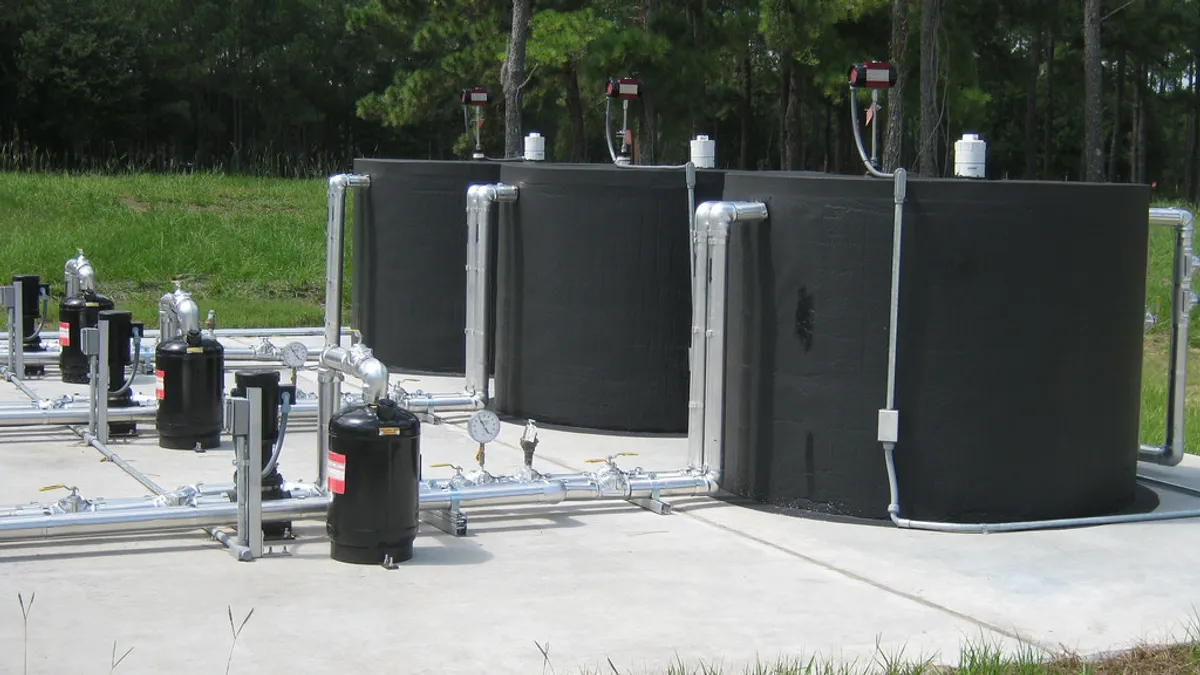Dive Brief:
- Thermal energy storage could boost potential long-duration storage, or LDES, capacity globally to between 2 TW and 8 TW, from a range of 1 TW to 3 TW by 2040, according to a recent report.
- It would translate to a cumulative investment of between $1.6 trillion and $2.5 trillion and increase the market size to a range of $1.7 trillion to $3.6 trillion by 2040, according to the Long-Duration Energy Storage Council and McKinsey & Co.
- Using LDES provides a longer duration firming capacity and energy curtailment or redispatch. This could save energy systems between $145 billion with 2 GW of TES installed and $540 billion with 8 GW of TES installed annually by 2040.
Dive Insight:
Using thermal energy storage, a material gains energy when increasing its temperature and loses it when the temperature drops. TES includes several technologies, such as medium-pressure steam, that provide storage durations from intraday to seasonal and temperatures as low as subzero to 2,400°C, the report said.
Media include water or ice-slush tanks, earth or bedrock reached by heat exchangers through boreholes, aquifers or pits filled with gravel and water among other elements.
The report focuses on the heat sector, a “pivotal component in achieving global decarbonization and climate targets.” The heat sector is comparable to the electricity sector, though with “clean-heat-specific technologies,” the report said. It includes thermal energy storage, dispatchable capacity such as clean-fuel boilers and robust quipment simiar to district heating.
Money saved for energy systems by LDES provides a longer duration firming capacity and avoids energy curtailment or redispatch.
Doron Brenmiller is co-founder of Brenmiller Energy, an Israeli company that has developed a thermal energy storage technology based on storing heat using crushed volcanic rocks. Available technologies such as thermal storage are maturing on a large scale and are commercially available and economical, he said in an interview.
"I think this report shows very clearly this is a mature alternative that is ready to be implemented," he said, adding he hopes to see more industrial players using thermal storage.
Hydrogen storage is getting much of the attention, but TES is more available and cost-effective, he said. The report said LDES, including TES, has drawn less focus historically because the “relatively small share of renewables could be accommodated without long-duration flexibility solutions.”
Brenmiller Energy and Enel, an Italian manufacturer and distributor of electricity and gas, launched a thermal energy storage system Nov. 4 in Santa Barbara, in Tuscany Italy.
During the charging phase, steam produced by the plant passes through pipes to heat crushed rocks and during discharging the accumulated heat is released to heat pressurized water and generate steam for electricity.
The system offers reduced power plant start-up times and greater speed in load variations, which the two companies said in a news release are necessary performance requirements for the efficient use of renewable energy. The system can be used to store excess energy from renewable sources in the form of heat to offer decarbonization services to industrial customers and provide long-term storage solutions with renewable plants, Brenmiller Energy and Enel said.














